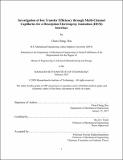| dc.contributor.advisor | David E. Hardt. | en_US |
| dc.contributor.author | Hsu, Chun-Cheng,M. Eng.Massachusetts Institute of Technology. | en_US |
| dc.contributor.other | Massachusetts Institute of Technology. Department of Mechanical Engineering. | en_US |
| dc.date.accessioned | 2021-05-24T19:53:01Z | |
| dc.date.available | 2021-05-24T19:53:01Z | |
| dc.date.copyright | 2020 | en_US |
| dc.date.issued | 2021 | en_US |
| dc.identifier.uri | https://hdl.handle.net/1721.1/130722 | |
| dc.description | Thesis: M. Eng. in Advanced Manufacturing and Design, Massachusetts Institute of Technology, Department of Mechanical Engineering, February, 2021 | en_US |
| dc.description | Cataloged from the official PDF of thesis. "February 2021." | en_US |
| dc.description | Includes bibliographical references (page 53). | en_US |
| dc.description.abstract | Desorption Electrospray Ionization (DESI) coupled with mass spectrometry (MS) is an efficient imaging technique for obtaining the spatial distribution of molecular species from a surface. In this study, we experimented with different capillary geometries to maximize the signal intensity of analyte peaks obtained through DESI by improving the temperature uniformity throughout the capillary flow. Multi-channel capillaries were discovered to be more sensitive to temperature and less prone to turbulence under certain conditions when compared to single channel capillaries. A multiple regression analysis reveals the significance of the surface-area-to-volume ratio, inlet-to-outlet area ratio, and the interaction of these main effects with temperature. This study illustrates the complex tradeoff between desolvation and ion loss, thereby providing a general guideline to instrumentation design for the purpose of maximizing signal intensity of the MS. | en_US |
| dc.description.statementofresponsibility | by Chun-Cheng, Hsu. | en_US |
| dc.format.extent | 53 pages | en_US |
| dc.language.iso | eng | en_US |
| dc.publisher | Massachusetts Institute of Technology | en_US |
| dc.rights | MIT theses may be protected by copyright. Please reuse MIT thesis content according to the MIT Libraries Permissions Policy, which is available through the URL provided. | en_US |
| dc.rights.uri | http://dspace.mit.edu/handle/1721.1/7582 | en_US |
| dc.subject | Mechanical Engineering. | en_US |
| dc.title | Investigation of ion transfer efficiency through multi-channel capillaries for a Desorption Electrospray Ionization (DESI) interface | en_US |
| dc.type | Thesis | en_US |
| dc.description.degree | M. Eng. in Advanced Manufacturing and Design | en_US |
| dc.contributor.department | Massachusetts Institute of Technology. Department of Mechanical Engineering | en_US |
| dc.identifier.oclc | 1251803670 | en_US |
| dc.description.collection | M.Eng.inAdvancedManufacturingandDesign Massachusetts Institute of Technology, Department of Mechanical Engineering | en_US |
| dspace.imported | 2021-05-24T19:53:01Z | en_US |
| mit.thesis.degree | Master | en_US |
| mit.thesis.department | MechE | en_US |
